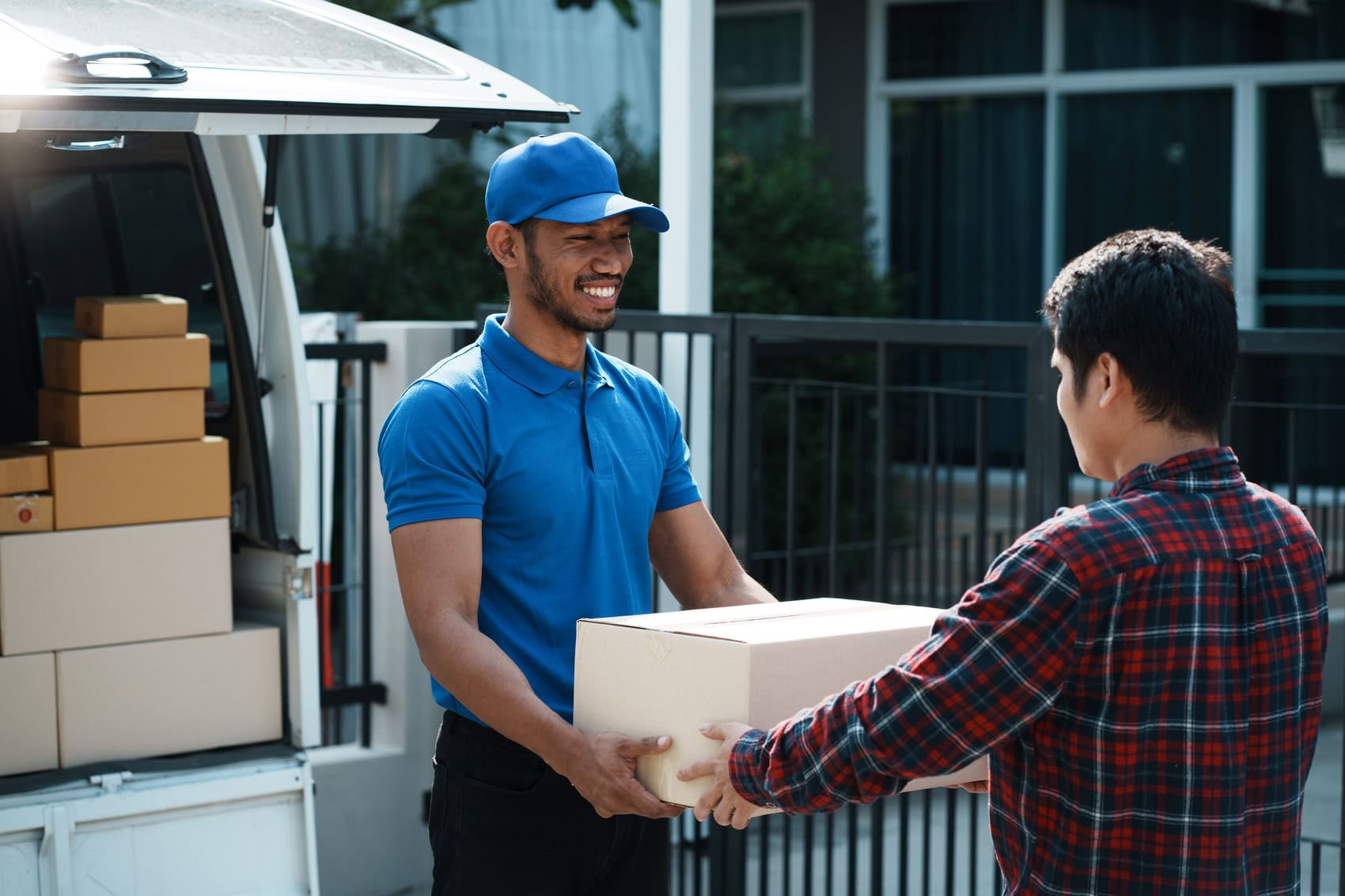Revolutionizing Last-Mile Delivery: 2024 Trends and Innovations
The last mile – that crucial stretch between a distribution center and your doorstep – is the heart of the e-commerce experience. In 2024, customer expectations for speed, convenience, and affordability are higher than ever. To keep pace, the future of last-mile delivery is brimming with exciting trends and innovations. Let’s delve into what’s shaping the landscape and how these advancements will transform the way we receive our online orders.

Emerging Trends of Last-Mile Delivery
- Sustainable Solutions: Consumers are increasingly environmentally conscious, and the last mile can be a significant contributor to emissions. In 2024, expect to see a surge in eco-friendly delivery options. Electric vehicles (EVs) are rapidly becoming more affordable and efficient, making them a viable choice for delivery fleets. Companies are also exploring alternative fuels like biofuels and hydrogen to further reduce their carbon footprint. Additionally, sustainable packaging solutions that minimize waste and utilize recycled materials are gaining traction.
- Hyper-Personalization: Gone are the days of one-size-fits-all delivery. In 2024, customization will be key. Customers will have more control over their deliveries, with options like choosing preferred delivery windows, selecting pick-up locations, and even specifying silent delivery for noise-sensitive areas. Advanced tracking technology will provide real-time updates, allowing customers to manage their deliveries seamlessly.
- Micro-Fulfillment Centers: Densely populated urban areas pose unique challenges for last-mile delivery. Micro-fulfillment centers, smaller warehouses strategically located within cities, are emerging as a game-changer. These centers store high-demand inventory closer to customers, enabling faster and more efficient deliveries, particularly for same-day or next-day orders.
- Collaboration: Competition in the delivery space is fierce, but collaboration is proving to be a winning strategy. Third-party logistics (3PL) providers are partnering with retailers and e-commerce platforms to offer a wider range of delivery options and optimize routes. Additionally, we’ll see more strategic partnerships between delivery companies, leveraging each other’s strengths to create a more robust delivery network.
- Big Data and AI: Data is the lifeblood of efficient last-mile delivery. In 2024, companies will leverage big data analytics to gain deeper insights into customer behavior, traffic patterns, and weather conditions. This data will be used to optimize delivery routes, predict demand surges, and ensure on-time deliveries. Artificial intelligence (AI) will play a crucial role in automating tasks, from route planning to dynamic pricing, further streamlining operations.
Innovations Redefining Last-Mile Delivery
The future of last-mile delivery is not just about trends; it’s about groundbreaking innovations that will fundamentally change how we receive our packages. Here are some intriguing advancements worth keeping an eye on:
- Autonomous Vehicles (AVs): While fully autonomous vehicles may still be a few years away, 2024 will see a significant increase in semi-autonomous delivery vehicles. These vehicles will navigate predefined routes in controlled environments, such as college campuses or business parks, offering a safe and efficient way to deliver packages.
- Drone Deliveries: Drone delivery is no longer science fiction. Companies are actively piloting drone delivery programs, particularly in remote areas or for time-sensitive deliveries. Regulations surrounding drone usage are continuously evolving, and as they become more relaxed, expect to see drones buzzing through the skies with your packages in tow.
- Smart Lockers: Smart lockers offer customers a convenient and secure alternative to traditional home deliveries. Packages can be delivered to these secure lockers located in convenient locations, allowing customers to pick them up at their leisure. Integration with mobile apps will provide real-time notifications and ensure a seamless experience.
- Robots: Delivery robots are making their way onto sidewalks. These small, autonomous robots can navigate sidewalks and deliver packages directly to customer doorsteps. While initially deployed in controlled environments, these robots have the potential to revolutionize short-distance deliveries in dense urban areas.
Challenges and Considerations
As exciting as these trends and innovations are, there are challenges to consider. Implementing sustainable solutions requires significant investment in infrastructure and technology. Regulations surrounding autonomous vehicles and drone deliveries need to be carefully crafted to ensure safety and privacy. The integration of AI and automation may raise concerns about job displacement, requiring careful planning and workforce training initiatives.
What This Means for You
As a consumer, these trends and innovations translate into a more empowered and personalized delivery experience. Here’s what you can expect:
- Greater Choice and Flexibility: You’ll have a wider range of delivery options to choose from, allowing you to select the most convenient and cost-effective option for your needs. Whether it’s same-day delivery via drone, pick-up at a nearby smart locker, or scheduling a delivery window that fits your busy schedule, the power will be in your hands.
- Real-Time Visibility and Control: Advanced tracking technology will provide unparalleled visibility into your deliveries. You’ll receive real-time updates on the location of your package, allowing for better planning and peace of mind. Additionally, features like delivery time slot adjustments or rerouting options based on your changing needs may become commonplace.
The Future is Collaborative
The future of last-mile delivery is not a single company’s race to the finish line. It’s a collaborative effort involving retailers, logistics providers, technology companies, and most importantly, consumers. By embracing these trends and innovations, we can all work together to create a more efficient, sustainable, and ultimately, more delightful delivery experience for everyone.
Conclusion:
As these trends and innovations continue to evolve, staying informed is key. Look for updates from your favorite retailers and delivery companies about their latest offerings. Provide feedback on your delivery experiences and voice your preferences for sustainable and convenient options. By actively participating, you can help shape the future of last-mile delivery just as myGermany does by ensuring it meets the needs of a dynamic and ever-evolving consumer landscape.
FAQ | Frequently Asked Questions
Can myGermany Pick-Up unpacked items in Germany & Pack it for international shipment?
Yes. We can pick up unpacked items with our dedicated driver. If your items are already packed (crates, pallets), we can use gathered trucks, which will be more cost effective. We can either ship directly to you, or get it into our warehouse where we check packaging and import/export conditions. We do pack, secure and support with export and customs formalities.
Can myGermany ship via Air, Sea, Road or Rail?
Yes. We do collaborate with several carriers and are able to provide you different shipping options via Air, Sea or Road. Best is to have the items in our warehouse where we understand packaging and export conditions in order to quote the international shipment.
Can myGermany handle the entire Pick-up process in Germany?
Yes. We handle the whole communication, payment and pick up if demanded. Please mind that articled need to be packed by the seller. Please also note that some articles are not in condition for an international transport, myGermany will check that upfront.We charge a 20,00 € standard fee for the Pick up Service (if higher pick-up costs occur, we will discuss with you before executing the pick up).
How do Freight Forwarding Services work?
myGermany can pick up your goods, consolidate them, pack them (e.g. build wooden crates or sea crates), prepare the shipping documents and then ship them via sea, air, rail or road.
We have a warehouse with ramp, forklift, high shelves and our employed carpenters can build packaging with ISSP certified wood.
Once we have the goods in our warehouse, we will discuss the packing and shipping options with you. Most of the time we still need to define or involve the customs agent in the receiving country. Once we agree, we find the appropriate aircraft or ships and book your goods onto them. You pay and advance and we initiate and control the shipment.
Taxes and customs duties in the receiving country are to be paid by you.
What are the Different Modes of freight transportation used?
We use Air, Road, Rail and Sea.
We collaborate with large carrier and cargo companies in order to find the perfect shipping option for you!
What Types of Cargo can be shipped through freight forwarding?
Almost everything which can legally be sent, please check here allowed goods.
And here some samples.
Do freight forwarders provide Customs Clearance Services?
Yes. We provide Export and Import Clearance Serices. We generate the export papers and also link you to customs brokers in your country, if needed.
Please check our Customs Clearance Services or Contact us.
What Documentation is required for freight forwarding?
We need
– packaging list
– commercial or pro forma invoice
– eventually export declaration
– eventually export and import certificated (e.g. certificate of origin)
– eventually master safety data sheet (MSDS)
– eventually dangerous goods
myGermany will support / generate all of these.
What happens if there are Delays or Disruptions in the shipment?
If carriers face any issues, myGermany is informed and will handle it. Whatever is needed, we support to create, procure or submit it.
Delays will be actively communicated to you.
How can I Insure my cargo during transportation?
We can insure new items easily against damages and loss, it will be an additional cost.
Used items can be insured for loss only.
The insurance value is linked to the export value and cannot be higher than the export value.
Can I consolidate Multiple Shipments into one Freight Container?
Yes you can. We gather your items here in our warehouse, store it until we have all things here to be shipped, and can consolidate/prepare/secure it in pallets, crates or containers to be shipped to you.
What Safety Measures are taken to Protect my cargo?
We have been working in the freight business since 2012 and employ freight packing specialists as well as carpenters to build sea chests.
We have shipped many things safely packed and demonstrably well kept, from antique old grandfather clocks, to pallets with glass vases, to entire kitchens and cars.
We use lashing straps, styrofoam, sea chests, inflatable container bags, hammer & nail to secure your goods.
How do I file a Claim for lost or Damaged Cargo?
You contact us and we do coordinate or submit the claim to the carrier.
Please check here.
Can I schedule Specific Delivery times for my Freight?
Yes you can. Please contact us.
Do freight forwarders offer Warehousing & Distribution services?
Yes, we do.
Check our Warehouse Services.
Check our Fulfillment Services.
What are the typical Transit Times for different Shipping Routes?
If we ship by air, it is faster than by ship, but it is also more expensive. Basically, the farther away and heavier/larger the goods, the more expensive the shipping.
We work with DHL, DSV, DBSchenker, FedEx, UPS etc. and can often access standard routes for air and sea, which are accordingly cheap.
Basically: SEA / AIR / STREET
North America West Coast 30-40d / 2-8d / na
South America East Coast 20d / 2-9d / na
Europe 5-10d / 2-5d / 2-9d
Africa 20d / 4-12d / na
Asia 30-40d / 4-12d / na
Australia 27-35d / 4-8d / na
Translated with www.DeepL.com/Translator (free version)



